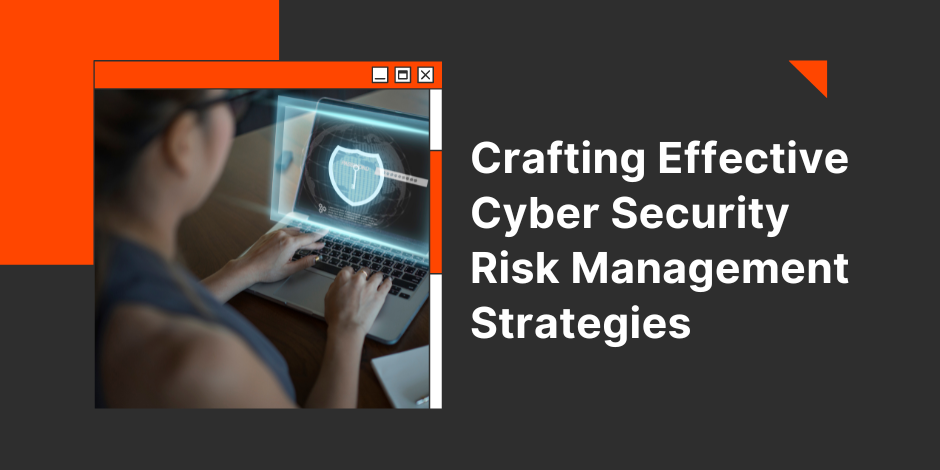Crafting Effective Cyber Security Risk Management Strategies

Stay Informed With Our Weekly Newsletter
Receive crucial updates on the ever-evolving landscape of technology and innovation.
Cyber Security is vital in protecting organisations from threats in today’s digital landscape.
As technology advances, robust cyber security risk management strategies become increasingly important.
Understanding the importance of cyber security risk management

Risk management is fundamental to cyber security. The ever-evolving nature of cyber threats highlights organisations’ need for a comprehensive strategy.
Cyber security risk management involves identifying potential risks, assessing their potential impact, and implementing appropriate measures to mitigate them.
As technology advances, the digital landscape becomes more complex, making it imperative for organisations to embrace risk management as an integral part of their cyber security strategy.
By doing so, they can stay ahead of cyber criminals and safeguard their critical assets.
The role of cyber security in today’s digital landscape
Cyber security is not just an optional feature but a fundamental requirement in today’s digital landscape.
With increasing organisations relying on technology, protecting sensitive information and infrastructure from malicious actors is paramount.
Organisations can avoid threats such as data breaches, ransomware attacks, and business disruptions with proper cyber security measures.
Organisations can proactively address vulnerabilities, mitigate risks, and protect their assets by implementing robust risk management strategies.
Why risk management is a critical aspect of cyber security
Risk management is critical to cyber security because it enables organisations to identify, assess, and mitigate potential risks.
By understanding their risks, organisations can implement appropriate measures to protect against them.
Organisations are left vulnerable to cyber attacks, data breaches, and financial losses without risk management.
By consistently evaluating and updating their cyber security risk management strategies, organisations can stay one step ahead of cyber threats and effectively protect their assets.
Identifying the critical components of an effective strategy
When crafting an effective cyber security risk management strategy, it is crucial to identify the key components that contribute to its success.
Organisations can create a robust and comprehensive approach that effectively addresses potential risks by focusing on these components.
The importance of a comprehensive risk assessment
Conducting a comprehensive risk assessment is an essential component of any effective risk management strategy.
This involves identifying potential threats, determining their likelihood and impact, and evaluating existing controls.
By conducting a thorough risk assessment, organisations can gain invaluable insights into their vulnerabilities and develop targeted strategies to mitigate them.
This proactive approach allows organisations to allocate resources effectively and implement the necessary safeguards.
The role of continuous monitoring in risk management
Effective risk management goes beyond implementing initial controls. It involves continuously evaluating potential risks.
By regularly monitoring the cyber landscape, organisations can detect emerging threats, identify vulnerabilities, and take prompt action.
Continuous monitoring allows organisations to proactively update their risk management strategies in response to evolving cyber threats.
By staying vigilant and up to date, organisations can effectively protect their assets and maintain a strong security posture.
Crafting a cyber security risk management strategy

Organisations must follow a step-by-step approach when developing a cyber security risk management strategy.
By taking the time to craft a tailored and robust strategy, organisations can effectively protect their critical assets from potential threats.
Steps to develop a robust risk management strategy
Developing a robust risk management strategy involves various steps.
Organisations must first assess their risk landscape and establish clear objectives and goals.
After identifying potential risks, organisations should then develop appropriate risk mitigation measures.
It is crucial to involve critical stakeholders in the development process, including IT personnel, management, and legal teams.
By collaborating and leveraging expertise, organisations can effectively create a comprehensive strategy that addresses potential risks.
Tailoring your strategy to your organisation’s needs
Every organisation is unique, and its risk management strategy should reflect that. It is essential to tailor the strategy to the specific needs and characteristics of the organisation.
This includes considering the protected data type, the industry, and the organisation’s goals and resources.
Organisations can allocate resources effectively, focus on significant risks, and implement appropriate controls by customising the strategy.
This tailored approach ensures that the risk management strategy is aligned with the organisation’s overall objectives and is more likely to be successful.
Implementing your cyber security risk management strategy
Implementing a cyber security risk management strategy is crucial to protecting an organisation’s critical assets.
However, it has its challenges. Organisations can ensure a smooth implementation process and ongoing strategy effectiveness by understanding and addressing these challenges.
Overcoming common challenges in strategy implementation
Implementing a cyber security risk management strategy can be complex, requiring collaboration and coordination across multiple departments.
Common challenges include resistance to change, lack of resources, and conflicting priorities.
To overcome these challenges, organisations should emphasise the importance of the strategy, provide adequate resources and training, and foster a culture of security awareness throughout the organisation.
By addressing these challenges head-on, organisations can ensure a successful implementation process.
Ensuring ongoing effectiveness of your strategy
A risk management strategy is not a one-time effort. It requires ongoing monitoring, evaluation, and adaptation.
To ensure the continued effectiveness of the strategy, organisations should regularly review and update their risk assessment, monitor emerging threats, and adjust their controls accordingly.
Additionally, organisations should conduct periodic audits and assessments to identify gaps or improvement areas.
By embracing a continuous improvement mindset, organisations can stay proactive and maintain a robust cyber security posture.
The future of cyber security risk management

As technology continues to evolve, the future of cyber security risk management is set to face new challenges and opportunities.
Organisations must stay informed about emerging trends and prepare for future cyber security challenges.
Emerging trends in cyber security risk management
One of the emerging trends in cyber security risk management is the increased adoption of artificial intelligence and machine learning technologies.
These technologies can help organisations analyse vast amounts of data, detect patterns, and identify potential risks more efficiently.
Another trend is the growing emphasis on employee training and awareness.
Organisations recognise the importance of educating their staff about cyber threats and best practices, as human error remains a significant factor in many security incidents.
Preparing for future cyber security challenges
To prepare for future cyber security challenges, organisations should prioritise ongoing education and training, as well as the implementation of advanced technologies.
Collaborating with industry peers and sharing best practices can help organisations stay ahead of threats and find innovative solutions.
Organisations can effectively manage future cyber security risks and protect critical assets by continuously adapting and innovating.
Conclusion
Crafting effective cyber security risk management strategies requires a comprehensive understanding of the digital landscape and the potential risks organisations face.
By identifying key components, such as conducting thorough risk assessments and embracing continuous monitoring, organisations can develop tailored strategies to protect their critical assets.
Are you interested in the dynamic world of cyber security?
The Institute of Data’s Cyber Security program offers in-depth knowledge and practical skills to prepare you for this exciting field of tech.
With guidance from industry professionals and real-world training, our program will ensure you’ll become proficient in safeguarding critical information.
Want to learn more? Reach out for a free career consultation today.




